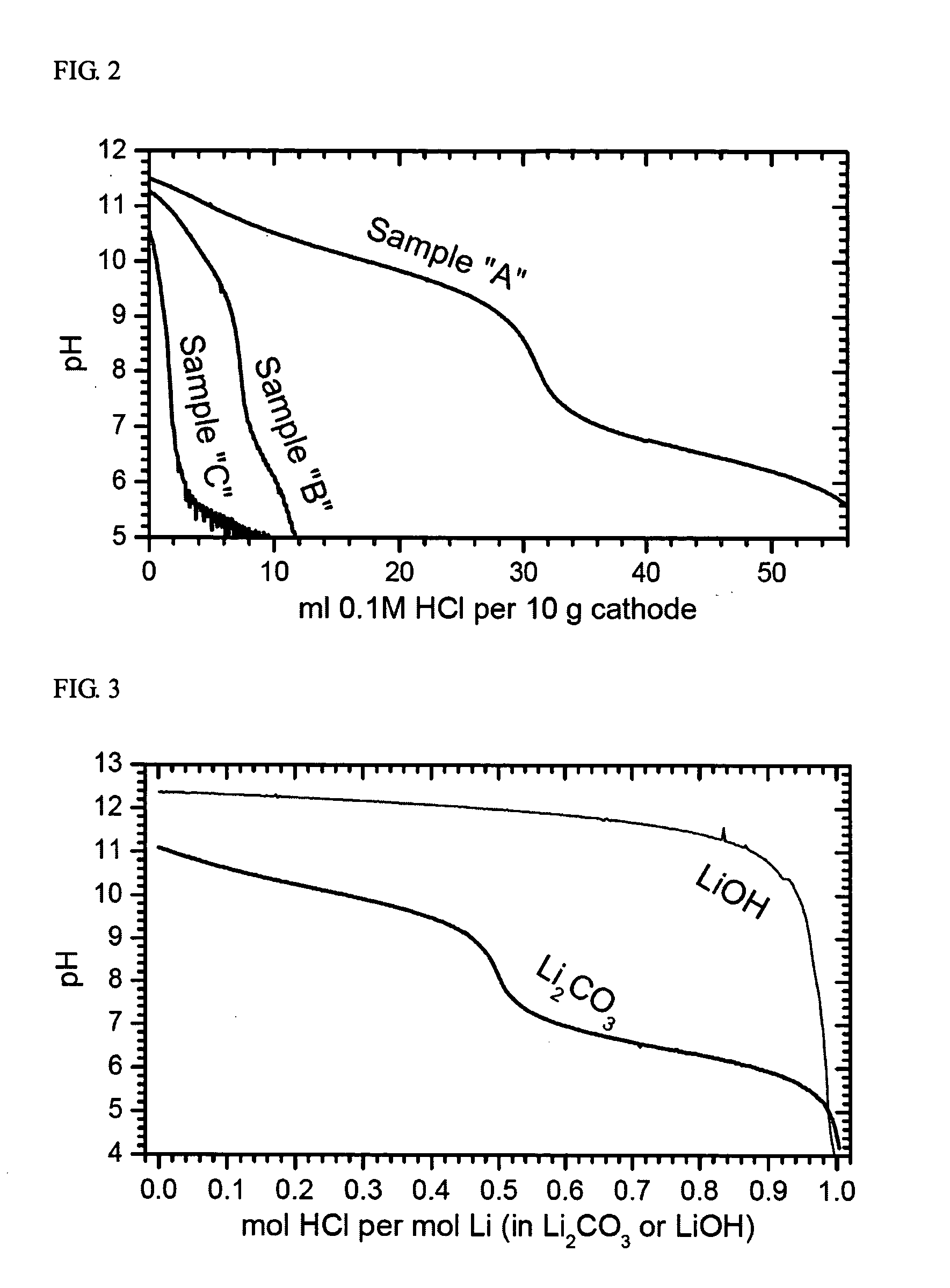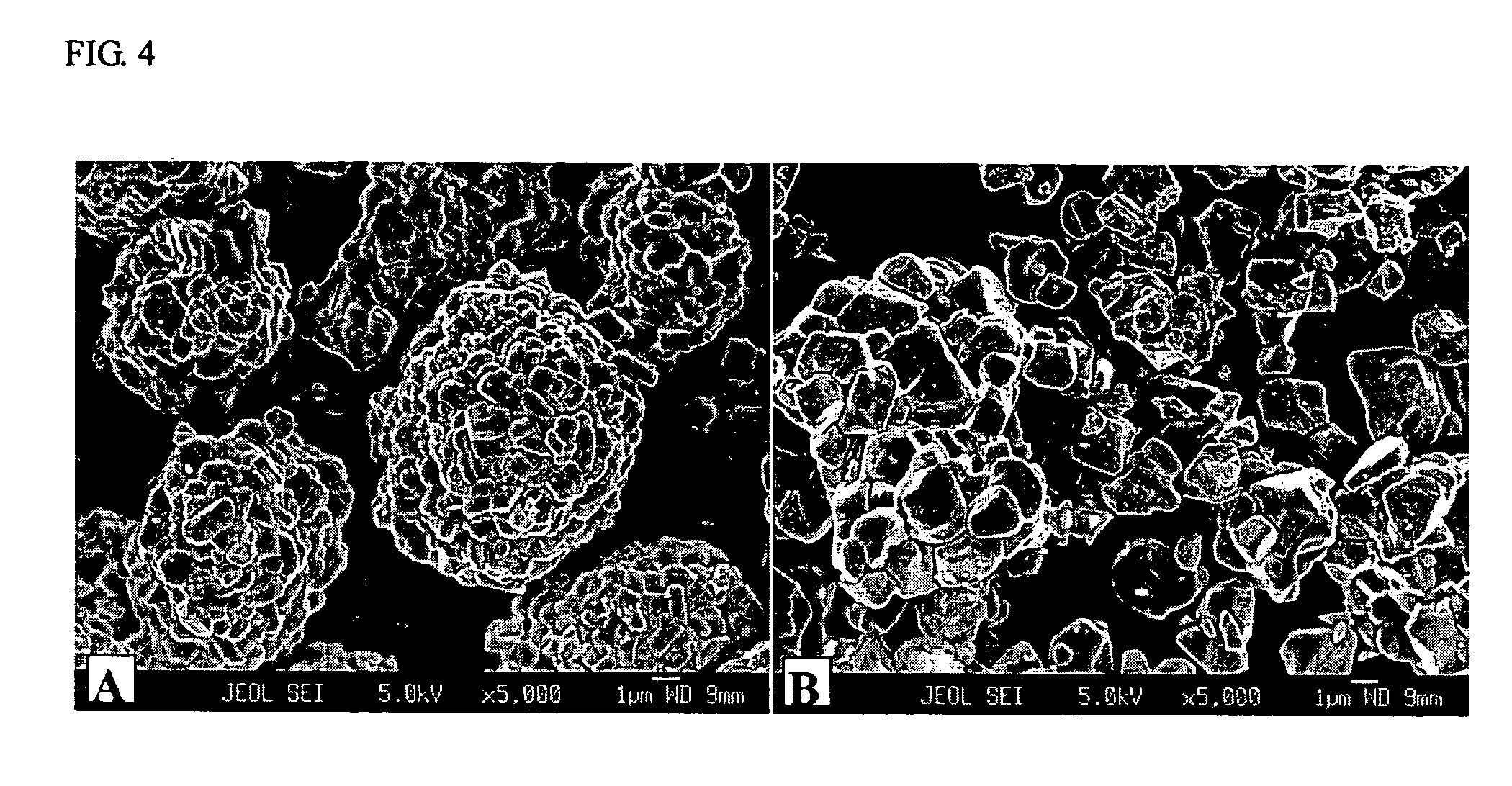Ni-based lithium transition metal oxide
a transition metal oxide and ni-based technology, applied in the direction of nickel compounds, manganates/permanentates, cell components, etc., can solve the problems of affecting the wide and successful implementation of liniosub>2, ni-based cathode active materials, and its price is expected to rise, so as to improve cycling stability and stability against aging, improve safety, and improve sintering stability. stability
- Summary
- Abstract
- Description
- Claims
- Application Information
AI Technical Summary
Benefits of technology
Problems solved by technology
Method used
Image
Examples
example 1
Sintering Stability
[0100] A mixed hydroxide MOOH with M=Ni4 / 15(Mn1 / 2Ni1 / 2)8 / 15Co0.2 was used as the transition metal precursors for preparation of nickel-based LiMO2. The transition metal composition of the final LiMO2 is marked as an asterik in FIG. 1. An intermediary sample was prepared by mixing the mixed hydroxide and Li2CO3 (stoichiometric ratio Li:M=1.02:1) and heating the resulting mixture to 700° C. in air. Samples (each approx. 50 g) of the intermediary sample were then sintered for 15 hours at various temperatures from 700 to 1000° C. in normal air. An improved sintering stability was observed at all of the temperatures. Secondary particles were maintained intact, and no disintegration into single crystallites as observed in Comparative Example 2 was observed. The size of crystallites increased with the sintering temperature.
[0101] X-ray analysis showed that all samples have a well-layered crystal structure. The unit cell volume did not change significantly with increase...
example 2
Li Stoichiometric Range
[0105] Samples with different Li:M ratios were prepared from MOOH with M=Ni4 / 15(Mn1 / 2Ni1 / 2)8 / 15Co0.2. Li2CO3 was used as a lithium source. 7 samples each of about 50 g with Li:M ratios ranging from 0.925 to 1.12 were prepared through two steps. The samples were first cooked at 700° C., followed by sintering at 910˜920° C. All heat treatments were carried out in normal air. Then, electrochemical properties were tested.
[0106] Table 4 below provides the obtained crystallographic data. The unit cell volume changes smoothly according to the Li:M ratio. FIG. 9 shows its crystallographic map. All samples are located on a straight line. FIG. 10 shows the results of pH titration. The content of soluble base increases slightly with the Li:M ratio. However, the total amount of soluble base is small. The soluble base probably originates from the surface basicity (ion exchange) but not from the dissolution of Li2CO3 impurity as observed in Comparative Example 1. This exp...
example 3
Large-Scale Sample Prepared in Air Using Li2CO3
[0107] Approx. 5 kg of LiMO2 was prepared in one batch. Precursors were Li2CO3 and a mixed hydroxide MOOH with M=Ni4 / 15(Mn1 / 2Ni1 / 2)8 / 15Co0.2. The preparation process involved 3 cooking steps. By heating to 700° C., a precursor with a Li:M ratio of approx. 1:1 was prepared. The furnace was a chamber furnace of about 20 liter volume; the sample was located in a tray of high-temperature steel. This precursor was sintered at 900° C. for 10 hours. During the sintering, air was pumped into the furnace. More than 10 m3 of air was fed into the oven during sintering for 10 hours. After the sintering, the unit cell constant was obtained by X-ray analysis, and the unit cell volume was compared with the target value. The target value was the unit cell volume of the sample in Example 2 which had the best electrochemical properties. pH titration of the sintered sample showed a profile very similar to that of Sample (E) in Example 2, which proves tha...
PUM
| Property | Measurement | Unit |
|---|---|---|
| temperature | aaaaa | aaaaa |
| temperature | aaaaa | aaaaa |
| temperature | aaaaa | aaaaa |
Abstract
Description
Claims
Application Information
 Login to View More
Login to View More - R&D
- Intellectual Property
- Life Sciences
- Materials
- Tech Scout
- Unparalleled Data Quality
- Higher Quality Content
- 60% Fewer Hallucinations
Browse by: Latest US Patents, China's latest patents, Technical Efficacy Thesaurus, Application Domain, Technology Topic, Popular Technical Reports.
© 2025 PatSnap. All rights reserved.Legal|Privacy policy|Modern Slavery Act Transparency Statement|Sitemap|About US| Contact US: help@patsnap.com



